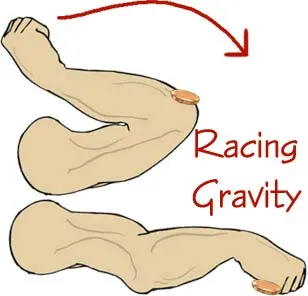 The Teacher's Corner
The Teacher's Corner
Catching Money - Racing Gravity
This week's experiment is one that I was reminded of while presenting a teacher workshop on hands-on science in the classroom this Saturday at a school in Miami. We were going over some of the easy, spur of the moment things that you can do for science and one of the teachers reminded me of this one. It is fun and a bit amazing too.
You will need:
- several coins
- space to practice where you won't break anything
 OK, here is the idea. You are going to balance a stack of coins on your right elbow (left if you are left handed) and then jerk your arm downwards and catch them in your right hand. Sounds hard? You will be surprised at how easy it is.
OK, here is the idea. You are going to balance a stack of coins on your right elbow (left if you are left handed) and then jerk your arm downwards and catch them in your right hand. Sounds hard? You will be surprised at how easy it is.
First, find a place where you won't break anything if you miss and send the coins flying. Be sure you have plenty of space to work. Open your right hand and bring it up so that it is on your right shoulder, with the palm facing upwards. Start with three coins. Place them in a stack and balance them on your elbow. Now comes the fun part. You are going to sweep your hand downwards as fast as you can. Be prepared to close your hand when it runs into the coins. I know it sounds hard, but try it. It may take a time or two, but you will be surprised at how easy it really is.
Now, why does it work? As you swing your hand downwards, your elbow moves downward too. As soon as your elbow moves, the coins begin to fall. At first, the coins are falling fairly slowly. If you did not catch them, the pull of gravity would cause them to fall faster and faster as they rushed towards the ground. In that first instant, your arm is moving much faster than the coins are falling, so it does not take long for your hand to catch up with them. Because of the way your arm is built, the coins that were resting on your elbow are at just the right distance from your body to be in the path you hand takes. All you have to do is have your hand open and be ready to grab the coins when your hand runs into them.
Once you have mastered three coins, you can try adding more. It seems that adding more coins would make it harder, but as long as they will all fit into your hand easily, it is just about as easy to catch ten as it is to catch three.
 Check out more Science Experiments
Check out more Science Experiments
All lessons are brought to you by The Teacher's Corner and Robert Krampf's Science Education Company.
Robert Krampf's Science Shows thehappyscientist.com